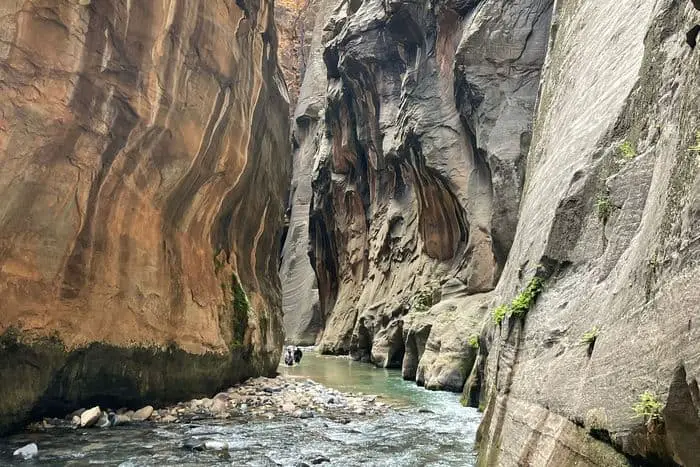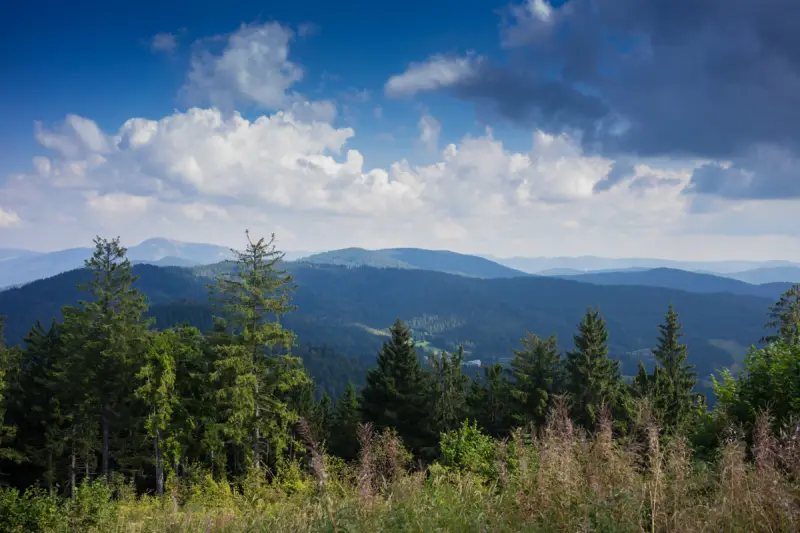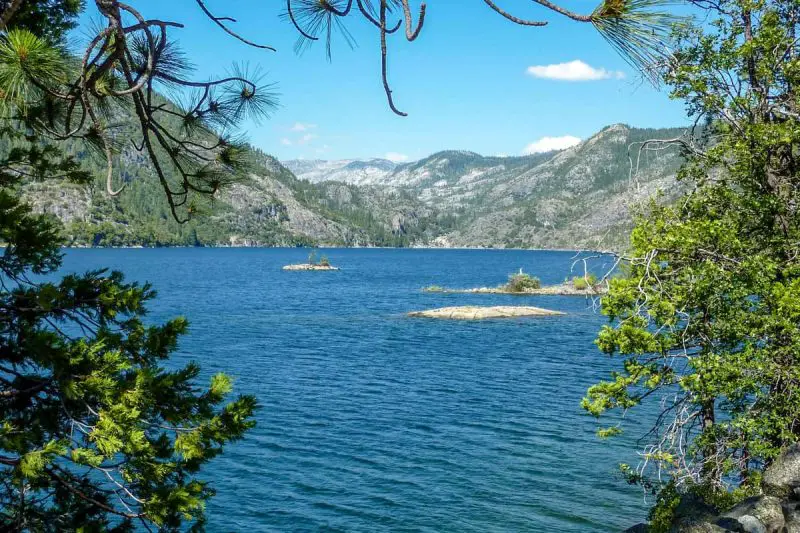The Wall Street And Narrows day hike, the most popular hike in Zion National Park, probably don’t require an intro, but I’ll give them one anyway. The Narrows of the Virgin River, also known as simply The Narrows, are one of Zion National Park’s most unusual features. The Virgin River is channeled down to a tiny canyon 22′ wide and nearly 1500′ deep in its narrowest sections as it carves its way through the park’s sandstone layers.
A wilderness permit is not required to trek the Narrows this route. Hike along the delightful Riverside Walk path from the Temple of Sinawava (the last station for the Zion Canyon shuttle bus transfer transportation system) until it finishes approximately a mile north. Now comes the exciting part: it’s time to begin trekking in the waters! You should always check the visitor center for any warnings before taking the hike.
Want more ideas to round-out your trip to Utah?
A lot of great ideas are in these posts!
- 24 Amazing Arches National Park Hiking Trails – Easy, Moderate, Hard
- 19 Great NE Utah Boondocking Spots With Maps
- 32 Free North-Central Utah Boondocking Areas Along With Maps
- 24 Top NW Utah Boondocking Locations Including Maps
- 51 Amazing East-Central Utah Boondocking Campsites And Maps
- 33 Best Central Utah Boondocking Sites Also Maps
- 21 Favorite West-Central Utah Boondocking Camp Sites Plus Maps
- 36 Free SE Utah Boondocking Camping Sites And Maps
- 43 Amazing South-Central Utah Boondocking Campgrounds With Maps
- 54 Top SW Utah Boondocking Camping Areas Including Maps
check out our video
How to Get to Wall Street
Begin either at the Navajo Loop trail at Sunset Point (our favorite route) or the Queen’s Garden trail at Sunrise Point to access Wall Street.
When you begin your journey at Sunset Point, you will take the descent into Wall Street near the start. You’ll ascend out Wall Street near the conclusion of your journey if you begin at the Queen’s Garden trail.
Wall Street is a section of Bryce Canyon’s Navajo Loop path, and one of two ways to enter and exit the canyon via the Navajo Loop trail (the other is Two Bridges).
Within a few minutes of leaving Sunset Point on the Navajo Loop route, you’ll come to a fork in the road with signs directing to the right for Wall Street and the left for the Two Bridges.

Expectations on Wall Street
NOTE: During the winter, the section of The Navajo Loop trail leading straight to Wall Street is frequently restricted. In trying to get to Wall Street during the winter, you may have to use the Queens Garden Circuit or the “long way around” the Navajo Loop.
Allow yourself plenty of time, this is such a great place and unique hike that you want to take in everything from starting point to the end of your day trip.
Whichever trail you choose, you’ll soon be dropping from the brink into the gorge. The journey back up is the most difficult portion of any of these hikes, as you will most certainly be climbing through a sequence of difficult switchbacks. Things to expect along the route are slippery rocks, and more water than you will probably want from the start of wall street all the way until you reach the end of wall street.
The number of people your encounter will depend on the time of year and the water levels. The later in the summer the shallower the water but you will find a lot of people during that time.
The Queens Garden Trail is not really a complete loop; it connects with the Navajo Loop Trail to bring you back to the rim. Based as to how far you wish to hike, you can incorporate any segment of either of these paths.
The paths are mostly built of compacted earth and are very level. Because they are among the park’s most popular, the trails are often used.
It almost feels like you’re entering a slot canyon after you get to Wall Street. The canyon isn’t that long – perhaps 10-15 feet – but the sides are extremely high.
You can take a little diversion farther into Wall Street through a clearing among the hoodoos before continuing on to link with the Queen Garden Trail or returning up to the rims via the Navajo Loop Trail at the base of Wall Street. This is an excellent time to gaze up and admire the magnificent structures that surround you.

What You Should Know About Wall Street
The Wall Street Narrows is a 16-mile stretch of the Virgin River that runs from Chamberlains Ranch to the Temple Of Sinawava in Zion Canyon’s main canyon. Hiking the entire route requires a permit, which can be difficult to obtain, and is usually done as a two-day backpacking trip.
This is for sure the much more typical trek up from the bottom (Temple Of Sinawava) as far as desire allows and back the same way. You can explore the tightest and deepest stretch of the Narrows, awe-inspiring location some reference to as the Wall Street, if you can make the trek for around 2 hours.
You’ll be hiking in knee-to-waist-deep water for the duration of the day, with the riverbed alternating between areas of sandy and portions with a lot of loose large boulders. The footing, , is like “walking on greasy bowling balls.” While the weather may not be too severe, hiking sticks and suitable boots will be essential.
Although the water is normally only waist deep, you may come across a few spots of shoulder water or even a spot or two where you may actually have to swim. While the current is usually gentle, numerous tiny crossings might be challenging to your balance. (If the water is very deep where you are, you can typically walk to the left or right to locate a more shallow alternative approach.)
You’ll cross Mystery Falls, a lovely place where water cascades down the sandstone walls from the canyon above, less than half a mile from the Temple of Sinawava. Around 2 miles from the Temple of Sinawava, you’ll reach the start of “Wall Street,” the narrowest portion of canyon where you’ll be hiking in the water virtually the entire trip, according to numerous Springdale outfitters. Then, on the right (east) bank of the river, you’ll cross the mouth of Orderville Canyon. There are other small waterfalls along the route as well.
Travel up Orderville Canyon as a quick trip:
If you want to take a break from the traditional Zion Narrows hike, head up Orderville Canyon. Orderville Canyon is an offshoot to the main Narrows that is considerably taller, deeper, and much more fascinating. The canyon has significantly less flowing water, but there are many difficulties to overcome that require some rock scrambling and swimming. Day trek in the Narrows of Zion
You’ll come to a small waterfall formation (dubbed “Veiled Falls” by some) about half a mile up Orderville Canyon, where the National Park Service has erected a sign prohibiting further passage upstream. While it is technically possible to climb up the waterfall and explore a little more, keep in mind that the descent is much more difficult.
The right (south) canyon wall has subtle moki stairs, but far too many people have jumped the from falls only to sprain an ankle and require assistance. Use your best judgment and don’t put too much pressure on yourself. When you’ve had your fill, turn around.
The Upper Narrows

The canyon stays gloomy and stunning as you continue up the Zion Narrows, with no high ground to ascend to in the event of a rainstorm or river flooding. Most people will continue up through this area before turning around after the scenery has calmed down. The next stretch, however, is more difficult if you have the time and energy, as the canyon is filled with big stones that obstruct parts of the river.
You might have to look about for a while to figure out the best method to climb on and around the obstructions and avoid a few shallower sections of water. There are no insurmountable difficulties, therefore always explore for alternatives.
After passing through the “rocky area of broken hearts,” the going becomes a little better, and Big Springs, another spectacular place where a stunning collection of springs and little falls emerge from the canyon walls, is reached in half a mile. This is the mandatory turn-around point for day hikers; no further journey upstream is authorized. When you’ve gotten your fill, turn around and head back the way you came to the Sinawava Temple. (A mile or so upstream of Orderville Canyon, most tourists turn around.)
Seasons, Water Levels, and Difficulty:
Summer and autumn are the most popular hiking seasons in the Zion Narrows, however the start of the season is determined by spring flows and water depth. Depending on how much snowfall fell in the high mountains throughout the winter, the Zion Narrows is usually closed to trekking between mid-March and late-May. Trekking in the Narrows didn’t even open until mid-July in record snowfall seasons like 2005 and 2011.
Please visit the Current Conditions page to review the current and average levels of water as well as see the melt of the snowpack in the spring. The best time is anytime you can find low water levels but there will still be enough cold water to keep you on your toes.
Note that you can hike the Narrows in the fall and winter if you are appropriately prepared for the chilly water; depending on the temps, a poor mans wetsuit bottoms or even drysuits may be required. If you wish to climb the top-down Narrows in the winter, keep in mind that the National Park Service will not issue a one-day top-down permit because there isn’t enough daylight to safely complete the hike. Snowfall or strong rains could also make Chamberlain’s Ranch’s gravel road impassable. The summer months to late falls is your best window for this hike.
Gear You Will Need
Water Shoes
Walking Stick or Sticks
Waterproof Backpack
Neoprene Socks
Dry Pants and Shirts
Water
Food

Day Trek in the Narrows of Zion Final Thoughts
Water flow has a significant impact on the difficulty of hiking the Zion Narrows. A flow of less than 50 cubic feet per second (CFS) implies reasonably easy trekking conditions, however a flow of more than 100 CFS might be tough and dangerous. If the waterflow in the Zion Narrows exceeds 120cfs, the Wilderness Desk will not grant a permit. It’s also worth noting that hiking becomes considerably more difficult few days after flash floods when the water is murky (like chocolate milk). The inability to see rocks beneath the water’s surface can significantly slow you down.
You May Want to Join Our Boondocking Group on Facebook For More Information
You May Want to Join Our Campfire Recipes Group on Facebook For More Information
Check Out Our Pictures On Instagram – Our Big Escape.

